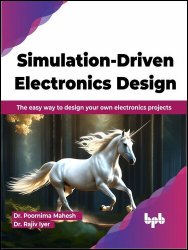Simulation-Driven Electronics Design: The easy way to design your own electronics projects
- Добавил: literator
- Дата: 24-04-2024, 15:56
- Комментариев: 0
 Название: Simulation-Driven Electronics Design: The easy way to design your own electronics projects
Название: Simulation-Driven Electronics Design: The easy way to design your own electronics projectsАвтор: Poornima Mahesh, Rajiv Iyer
Издательство: BPB Publications
Год: 2024
Страниц: 543
Язык: английский
Формат: pdf, epub
Размер: 25.3 MB
Your step-by-step guide to designing and programming electronics.
Key Features:
- Create interactive and responsive electronic systems by constructing sensor-based Arduino projects.
- Learn how to apply and simulate Analog devices in diverse electronic applications.
- Design custom circuit boards using TI tools through PCB learning.
Description:
Simulation plays a vital role in the design of electronics-based projects, as it effectively saves time and money for users by eliminating the need for hardware trial and error. If you want to understand the significance of simulation as an indispensable tool for efficiently iterating, analyzing, and optimizing your electronic projects, this book is a valuable resource.
This book introduces you to the essential tools commonly used by professional electronic project designers. Through this guide, you will gain the ability to select various components suitable for your projects and simulate them without fear of causing any damage. Additionally, the book provides instruction on using diverse simulation tools, enabling you to undertake a wide range of projects—such as building power supplies, designing PCBs, and integrating sensors with microprocessors/microcontrollers.
By gaining familiarity with design and simulation tools throughout the project development process, this book aims to empower project builders, transforming them into self-assured and capable designers.
Chapter 1: Introduction to the World of Electronics—1—Passive will give an introduction to passive electronic components, including basic working principles, symbols, and design considerations. Various passive elements, such as resistors, inductors, and capacitors, are discussed in detail.
Chapter 2: Introduction to the World of Electronics—2—Active discusses active elements and their working. It discusses various factors, which include the choice of a particular component, the parameters to make that decision, etc. Diode, LED, transistor, and MOSFET are discussed in detail. It also includes sensors to be used in different projects. Digital and logic circuits are also included in this chapter.
Chapter 3: Basic Arduino Projects Using starts with the online tool Tinkercad. It gives step-by-step ideas to create various projects on that tool. The reader learns to work with Arduino and builds basic projects using LEDs and resistors.
Chapter 4: Sensor-based Arduino introduces readers to various sensors available in Tinkercad, and they learn to integrate these sensors with Arduino to build projects. In this chapter, they will learn to use LED, Ultrasonic sensors, PIR sensors, gas sensors, alarms, etc. They will also learn block coding using Tinkercad.
...
Chapter 11: PCB Designing TI emphasizes the importance of printed circuit boards (PCB) in every project. It demonstrates the use of the TI Tool for PCB designing.
Chapter 12: PCB Thermal explains thermal calculations for various cases. It helps in estimating the junction temperature of components based on the copper spreading area on the PCB.
What you will learn:
- Streamline the design process in electronics using the Webench (TI) tool.
- Design power supplies using the TI Webench for efficient and reliable electronic devices.
- Achieve precise and effective filtering in electronic circuits using the TI Filter Designer.
- Master Filter Design techniques for signal processing and noise reduction.
- Gain comprehensive circuit analysis skills by exploring the TI analog simulation tool and understanding basic circuits.
Who this book is for:
This book targets students, electronics and computer graduates, robotics hobbyists, and individuals interested in creating their own electronic gadgets. It serves as a guide for beginners by introducing basic electronic concepts and the functioning of commonly used components. For expert users, it acts as a refresher, ensuring a comprehensive understanding of electronics.
Contents:
Скачать Simulation-Driven Electronics Design: The easy way to design your own electronics projects
[related-news] [/related-news]
Внимание
Уважаемый посетитель, Вы зашли на сайт как незарегистрированный пользователь.
Мы рекомендуем Вам зарегистрироваться либо войти на сайт под своим именем.
Уважаемый посетитель, Вы зашли на сайт как незарегистрированный пользователь.
Мы рекомендуем Вам зарегистрироваться либо войти на сайт под своим именем.

